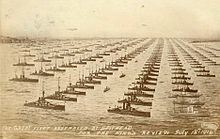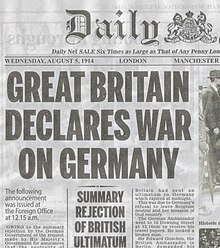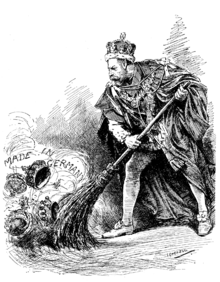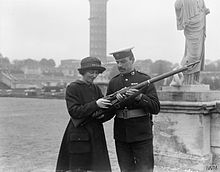
A Zeppelin is a type of rigid airship named after the German inventor Ferdinand von Zeppelin who pioneered rigid airship development at the beginning of the 20th century. Zeppelin's notions were first formulated in 1874 and developed in detail in 1893. They were patented in Germany in 1895 and in the United States in 1899. After the outstanding success of the Zeppelin design, the word zeppelin came to be commonly used to refer to all forms of rigid airships. Zeppelins were first flown commercially in 1910 by Deutsche Luftschiffahrts-AG (DELAG), the world's first airline in revenue service. By mid-1914, DELAG had carried over 10,000 fare-paying passengers on over 1,500 flights. During World War I, the German military made extensive use of Zeppelins as bombers and as scouts. Numerous bombing raids on Britain resulted in over 500 deaths.

David Lloyd George, 1st Earl Lloyd-George of Dwyfor, was Prime Minister of the United Kingdom from 1916 to 1922. A Liberal Party politician from Wales, he was known for leading the United Kingdom during the First World War, for social-reform policies, for his role in the Paris Peace Conference, and for negotiating the establishment of the Irish Free State. He was the last Liberal Party prime minister; the party fell into third-party status shortly after the end of his premiership.
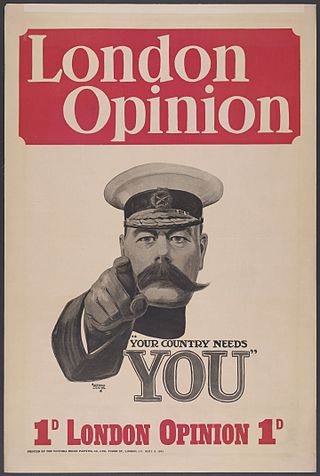
At the beginning of 1914 the British Army had a reported strength of 710,000 men including reserves, of which around 80,000 were professional soldiers ready for war. By the end of the First World War almost 25 percent of the total male population of the United Kingdom of Great Britain and Ireland had joined up, over five million men. Of these, 2.67 million joined as volunteers and 2.77 million as conscripts. Monthly recruiting rates for the army varied dramatically.
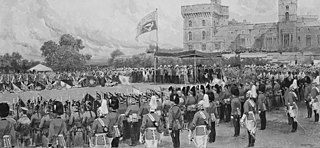
The Territorial Force was a part-time volunteer component of the British Army, created in 1908 to augment British land forces without resorting to conscription. The new organisation consolidated the 19th-century Volunteer Force and yeomanry into a unified auxiliary, commanded by the War Office and administered by local county territorial associations. The Territorial Force was designed to reinforce the regular army in expeditionary operations abroad, but because of political opposition it was assigned to home defence. Members were liable for service anywhere in the UK and could not be compelled to serve overseas. In the first two months of the First World War, territorials volunteered for foreign service in significant numbers, allowing territorial units to be deployed abroad. They saw their first action on the Western Front during the initial German offensive of 1914, and the force filled the gap between the near destruction of the regular army that year and the arrival of the New Army in 1915. Territorial units were deployed to Gallipoli in 1915 and, following the failure of that campaign, provided the bulk of the British contribution to allied forces in the Sinai and Palestine Campaign. By the war's end, the Territorial Force had fielded twenty-three infantry divisions and two mounted divisions on foreign soil. It was demobilised after the war and reconstituted in 1921 as the Territorial Army.

Peter Strasser was chief commander of German Imperial Navy Zeppelins during World War I, the main force operating bombing campaigns from 1915 to 1917. He was killed when flying the German Empire's last airship raid over the United Kingdom.

The Shell Crisis of 1915 was a shortage of artillery shells on the front lines in the First World War that led to a political crisis in the United Kingdom. Previous military experience led to an over-reliance on shrapnel to attack infantry in the open, which was negated by the resort to trench warfare, for which high-explosive shell were better suited. At the start of the war there was a revolution in doctrine: instead of the idea that artillery was a useful support for infantry attacks, the new doctrine held that heavy guns alone would control the battlefield. Because of the stable lines on the Western Front, it was easy to build railway lines that delivered all the shells the factories could produce. The 'shell scandal' emerged in 1915 because the high rate of fire over a long period was not anticipated and the stock of shells became depleted. The inciting incident was the disastrous Battle of Aubers, which reportedly had been stymied by a lack of shells.
The Minister of Munitions was a British government position created during the First World War to oversee and co-ordinate the production and distribution of munitions for the war effort. The position was created in response to the Shell Crisis of 1915 when there was much newspaper criticism of the shortage of artillery shells and fear of sabotage. The Ministry was created by the Munitions of War Act 1915 passed on 2 July 1915 to safeguard the supply of artillery munitions. Under the very vigorous leadership of Liberal party politician David Lloyd George, the Ministry in its first year set up a system that dealt with labour disputes and fully mobilized Britain's capacity for a massive increase in the production of munitions.

The United Kingdom was a leading Allied Power during the First World War of 1914–1918. They fought against the Central Powers, mainly Germany. The armed forces were greatly expanded and reorganised—the war marked the founding of the Royal Air Force. The highly controversial introduction, in January 1916, of conscription for the first time in British history followed the raising of one of the largest all-volunteer armies in history, known as Kitchener's Army, of more than 2,000,000 men. The outbreak of war was a socially unifying event. Enthusiasm was widespread in 1914, and was similar to that across Europe.

During World War I, the German Empire was one of the Central Powers. It began participation in the conflict after the declaration of war against Serbia by its ally, Austria-Hungary. German forces fought the Allies on both the eastern and western fronts, although German territory itself remained relatively safe from widespread invasion for most of the war, except for a brief period in 1914 when East Prussia was invaded. A tight blockade imposed by the Royal Navy caused severe food shortages in the cities, especially in the winter of 1916–17, known as the Turnip Winter. At the end of the war, Germany's defeat and widespread popular discontent triggered the German Revolution of 1918–1919 which overthrew the monarchy and established the Weimar Republic.

The East African campaign in World War I was a series of battles and guerrilla actions, which started in German East Africa (GEA) and spread to portions of Mozambique, Rhodesia, British East Africa, the Uganda, and the Belgian Congo. The campaign all but ended in German East Africa in November 1917 when the Germans entered Mozambique and continued the campaign living off Portuguese supplies.

Opposition to World War I was widespread during the conflict and included socialists, anarchists, syndicalists and Marxists as well as Christian pacifists, anti-colonial nationalists, feminists, intellectuals, and the working class.
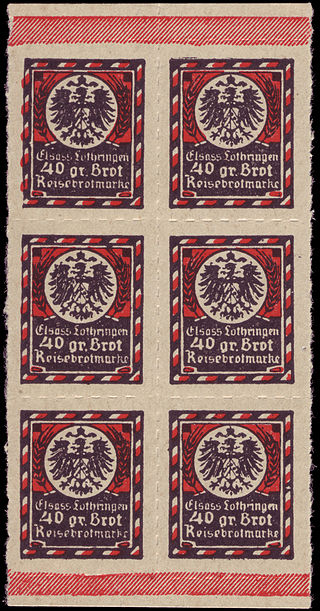
The Blockade of Germany, or the Blockade of Europe, occurred from 1914 to 1919. The prolonged naval blockade was conducted by the Allies during and after World War I in an effort to restrict the maritime supply of goods to the Central Powers, which included Germany, Austria-Hungary, and the Ottoman Empire. The blockade is considered one of the key elements in the eventual Allied victory in the war. In December 1918, the German Board of Public Health claimed that 763,000 German civilians had already died from starvation and disease caused by the blockade. An academic study done in 1928 put the death toll at 424,000. An additional 100,000 people may have died during the post-armistice continuation of the blockade in 1919.

Strategic bombing during World War I was principally carried out by the United Kingdom and France for the Entente Powers and Germany for the Central Powers. Most of the belligerents of World War I eventually engaged in some form of strategic bombing. The aerial bombing of cities, intended to destroy the enemy's morale, was introduced in the opening days of the war. A multi-national air force to strike at Germany was planned but never materialized.
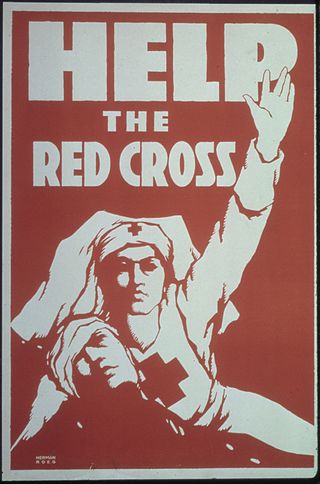
The home front during World War I covers the domestic, economic, social and political histories of countries involved in that conflict. It covers the mobilization of armed forces and war supplies, lives of others, but does not include the military history. For nonmilitary interactions among the major players see diplomatic history of World War I.
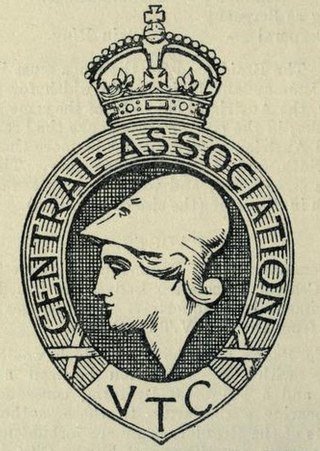
The Volunteer Training Corps was a voluntary home defence reserve force in the United Kingdom during World War I.

The economic history of World War I covers the methods used by the First World War (1914–1918), as well as related postwar issues such as war debts and reparations. It also covers the economic mobilization of labour, industry, and agriculture leading to economic failure. It deals with economic warfare such as the blockade of Germany, and with some issues closely related to the economy, such as military issues of transportation. For a broader perspective see home front during World War I.

Parisians entered the First World War (1914-1918) in August 1914 on a wave of patriotic fervor, but within a few weeks Paris was close to the front lines and bombarded by German aircraft and artillery. The Parisians endured food shortages, rationing, and an epidemic of influenza, but morale remained high until near the end of the war. With the departure of young men to the front lines, women took a much greater place in the work force. The city also saw a large influx of immigrants who came to work in the defense factories. The end of the war on November 11, 1918, saw huge celebrations on the boulevards of Paris.
The British home army in the First World War served the dual purpose of defending the country against invasion and training reinforcements for the army overseas. Initial responsibility for defending the nation lay with the Territorial Force, a part-time auxiliary designed in 1908 as a means of expanding the army in a major foreign conflict but, as a result of political compromise, implemented as a home defence army. It was supported in this role by 42,000 regular army troops, primarily belonging to the Royal Garrison Artillery and the Royal Engineers. The 14 infantry divisions and 14 mounted brigades of the Territorial Force were mainly allocated either to the Local Force, stationed near the coast and tasked with disrupting an invasion at the point of landing, or the Central Force, a mobile element tasked with defeating the invading force as it marched on London. The Local Force was augmented by units of the Special Reserve and Extra Reserve, which were the third battalions of the regular army line infantry regiments established to recruit and train replacements for their regiments' two combat battalions. The home army was also largely responsible for guarding vulnerable points, such as the communications infrastructure, rail network and munitions works.

The Women's Reserve Ambulance Corps was a volunteer aid organisation set up in the United Kingdom in 1915 during the First World War. Its members worked to direct people at stations, transport hospital patients and render assistance during German bombing raids. The corps sent personnel to the Dardanelles during the Gallipoli campaign and arranged the first all-female ambulance convoy to the British Army on the Western Front. The corps became a founding member of the Women's Army Auxiliary Corps in 1917 and continued in existence until September 1919.

The onset of the 20th century saw England as the world's foremost naval and colonial power, supported by a 100,000-man army designed to fight small wars in its outlying colonies. Since the Napoleonic Wars nearly a century earlier, Britain and Europe had enjoyed relative peace and tranquility. The onset of World War I caught the British Empire by surprise. As it increased the size of its army through conscription, one of its first tasks was to impose a complete naval blockade against Germany. It was not popular in the United States. However, it was very important to England.

